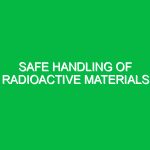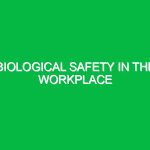Introduction
In today’s world, the presence of radiation is an undeniable reality. From medical imaging to nuclear power generation, radiation plays a crucial role in various sectors. However, with its benefits come significant risks. Monitoring and limiting radiation exposure is essential, particularly in the Health, Safety, and Environment (HSE) domain. This process not only safeguards workers and the public but also ensures compliance with legal standards.
Radiation exposure can result from natural sources, such as cosmic rays and radon gas, or artificial sources, including medical devices and industrial applications. Understanding the implications of radiation exposure is vital for maintaining workplace safety and public health. In this article, we will explore the hazards associated with radiation exposure, best practices for monitoring and limiting it, and the regulatory framework that governs these activities.
Understanding Radiation Exposure
Radiation is energy that travels through space and takes the form of particles or electromagnetic waves. There are two primary types of radiation: ionizing and non-ionizing. Ionizing radiation, which includes X-rays and gamma rays, has enough energy to remove tightly bound electrons from atoms, leading to cellular damage. Non-ionizing radiation, like microwaves and radio waves, does not carry enough energy to ionize atoms but can still pose health risks at high exposure levels.
The need for monitoring and limiting radiation exposure stems from its potential health effects, which can range from acute radiation syndrome to long-term consequences like cancer. It’s not just the amount of radiation that matters; the duration and frequency of exposure are equally critical. The HSE domain focuses on minimizing these risks through systematic monitoring and stringent safety practices.
Potential Hazards and Risks Associated with Radiation Exposure
Radiation hazards can be broadly categorized into two types: external and internal. External radiation comes from sources outside the body, such as radioactive materials or X-ray machines. Internal radiation occurs when radioactive substances are ingested or inhaled, leading to internal exposure.
Some of the risks associated with radiation exposure include:
- Acute Radiation Syndrome (ARS): This condition can occur after a high dose of radiation over a short period. Symptoms include nausea, vomiting, and even death in severe cases.
- Long-term Health Effects: Prolonged exposure to radiation increases the risk of cancers, particularly leukemia and thyroid cancer.
- Genetic Mutations: Radiation can cause changes in DNA, leading to hereditary diseases in future generations.
- Environmental Impact: Radioactive waste can contaminate soil and water, posing risks to both humans and wildlife.
These risks underscore the importance of implementing effective monitoring and limiting strategies to protect individuals and the environment from radiation exposure.
Best Practices for Monitoring and Limiting Radiation Exposure
To effectively manage radiation exposure, it’s crucial to adopt comprehensive monitoring strategies and safety practices. Here are some actionable steps that can be taken:
1. Regular Monitoring
Employing radiation detection devices is essential for continuous monitoring. Dosimeters, Geiger counters, and scintillation counters are widely used tools that help measure radiation levels in various environments. Workers should wear personal dosimeters to track their exposure over time. Regular inspections and calibration of these devices ensure accurate readings.
2. Establishing Radiation Safety Protocols
Organizations must develop and enforce radiation safety protocols. This includes defining restricted zones, implementing access controls, and instituting safety training programs for employees. Clear signage should indicate areas where radiation is present, and protocols should outline procedures for emergencies, such as spills or equipment failures.
3. Utilizing Engineering Controls
Engineering controls, such as shielding and containment, are vital in reducing exposure. Shielding materials, like lead or concrete, can significantly decrease radiation levels in workspaces. In nuclear facilities, containment structures prevent the release of radioactive materials into the environment.
4. Administrative Controls and Work Practices
Limiting the time spent near radiation sources, increasing distances from these sources, and rotating workers to minimize cumulative exposure are effective administrative controls. Training programs should emphasize the importance of following these practices to ensure worker safety.
5. Personal Protective Equipment (PPE)
Using appropriate PPE, such as lead aprons, gloves, and face shields, is crucial when working in environments with potential radiation exposure. PPE acts as a barrier between the radiation source and the worker, significantly reducing exposure risk. Regular inspections and maintenance of PPE are essential to ensure their effectiveness.
Regulatory Framework Governing Radiation Exposure
Several regulations and standards govern radiation exposure to ensure public safety and environmental protection. These include:
1. International Atomic Energy Agency (IAEA) Standards
The IAEA sets international safety standards for nuclear and radiation safety, providing a framework for member states to implement effective radiation protection measures.
2. United States Environmental Protection Agency (EPA)
The EPA regulates radiation exposure in the U.S., focusing on protecting the public and environment from the harmful effects of radiation. This includes setting limits on emissions and monitoring radioactive waste management practices.
3. Occupational Safety and Health Administration (OSHA)
OSHA establishes regulations to protect workers from radiation hazards in the workplace. This includes setting permissible exposure limits (PELs) and requiring employers to implement monitoring and safety measures.
4. National Council on Radiation Protection and Measurements (NCRP)
The NCRP provides guidance on radiation protection and measurement, emphasizing best practices to minimize exposure risks in various sectors.
Conclusion
Monitoring and limiting radiation exposure is a critical aspect of the Health, Safety, and Environment domain. By understanding the potential hazards and implementing effective safety measures, organizations can protect their workers, the public, and the environment from the harmful effects of radiation.
As we advance in technology and expand our use of radiation in various fields, ongoing education, adherence to regulatory standards, and a commitment to safety will be paramount. Remember, in the realm of radiation safety, vigilance is key. By fostering a culture of safety and awareness, we can navigate the complexities of radiation exposure while reaping its benefits responsibly.


